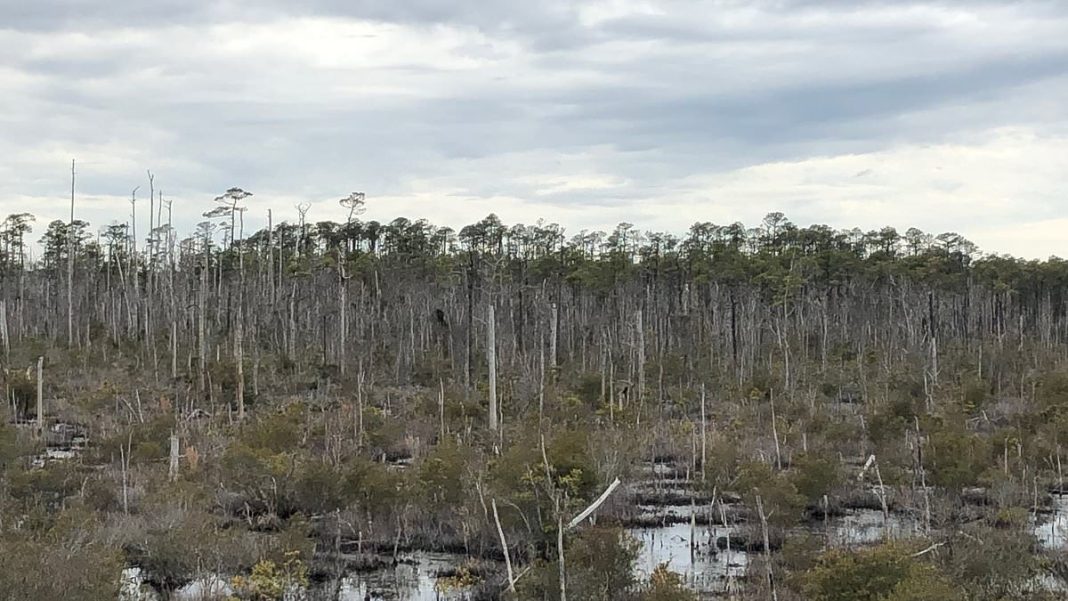‘Ghost forests’ in North Carolina are visible from space,
Spooky ‘ghost forests’ are spreading rapidly through North Carolina, becoming so pervasive that they are visible from space.
A pair of satellite images from October 2005 and October 2024 show the spread of the dead trees in Albemarle-Pamlico Peninsula, home of the Alligator River National Wildlife Refuge.
In the images, the ghost forest appears light brown and stands out against the bright green healthy forest.
NASA’s data shows that in the last 20 years, the watery remains of a once verdant woodland have grown substantially larger, stretching further inland.
A 2021 study found that 11 percent of forestland in the state’s largest coastal wildlife refuge became ghost forest from 1985 to 2019.
This is due to rising seal levels that are pushing seawater into the soils and fresh groundwater that trees rely on for sustenance.
The salty water slowly poisons the trees, leaving behind ghoulish, lifeless forests.
Even North Carolina’s iconic bald cypress forests, which are among the oldest trees in the US, are falling victim to this trend.
Sea level along North Carolina is rising by about three to four millimeters per year, about three times faster than the global average, according to NASA Earth Observatory.
‘However, the death of forests in the Alligator River Wildlife Refuge hasn’t tracked exactly with the rate of sea level rise,’ the space agency shared.
‘Instead, these forests saw a particularly large die-off in 2011 following a severe drought and a direct hit by Hurricane Irene.’
This is according to the 2021 study, which was published in the journal Ecological Applications. The researchers concluded that the formation of ghost forests peaked between 2011 and 2012.
‘The drought reduced the flow of rivers and allowed saltwater to flow upstream and through irrigation canals, killing trees in the process.’
As saltwater encroaches upon coastal forests, trees are shedding their foliage and bark and becoming pale, leafless snags.
Eventually, these trees fall and decompose. But while still standing, they have a distinctly ghoulish appearance.
This is because saltwater damages roots, leaves and contaminates the resources that trees need to survive.
Excessive salt levels in soils can harm a tree’s roots, making it difficult for them to absorb water an nutrients.
This leads to nutrient imbalances and deficiencies that can make trees sick and eventually kill them.
Saltwater can also draw water out of leaves faster than trees can replace it, causing them to turn brown and drop prematurely.
This hinders a tree’s ability to absorb energy from the sun.
And when saltwater replaces fresh groundwater, trees lose their water source, suffering from drought stress even when there is plenty of water underground.
‘The closer a forest is to sea level, the greater the risk of tree death and the detection of ghost forests,’ Xi Yang, an environmental scientist at the University of Virginia told NASA Earth Observatory.
And land development is making this problem even worse.
‘You can also see the effects of climate change collide with human development in Landsat images like this,’ Duke University ecologist Emily Bernhard told NASA Earth Observatory.
‘Marshes shift locations over time as sea levels rise, but there’s nowhere for cypress forests to go. They’re already hemmed in by farmland or other development, so these iconic wetlands are getting squeezed and dying off in mass mortality events instead,’ she added.
The combination of these pressures is so harmful that it’s killing trees that have survived everything nature has thrown at them for thousands of years.
North Carolina’s bald cypress trees are among the oldest in the US.
Known for their reddish-brown bark, green needle-like leaves and clusters of knobby ‘knees’ around their trunks, these enormous trees thrive in freshwater swamps and can reach heights over 100 feet, according to NASA Earth Observatory.
But now, these ancient trees are being reduced to lifeless ghosts as saltwater invades the wetlands they call home.
North Carolina isn’t the only state seeing the rise of ghost forests. These haunting trees are popping up throughout the East Coast, from Florida to Maine.
Healthy coastal forests serve as natural buffers against storm surges and erosion. But as rising global temperatures increase the stress put on these trees, North Carolina and other East Coast states are losing that protection.









